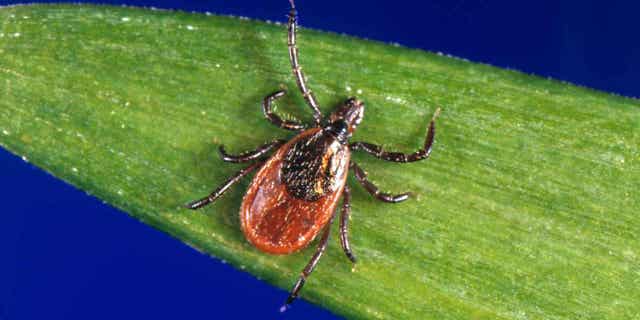Mild winter could mean an uptick in ticks, Lyme disease across the US
Infected ticks can spread viruses, parasites, bacteria
- A tick expert from Connecticut predicts "an above average year for tick activity" because of this year's mild winter.
- Lyme disease is common in the Northeast and Midwest, and is the most common tick-borne infection in the United States.
- Tick season in the United States generally stretches from April to October. The insects are mostly dormant during the winter months.
After a mild winter in the U.S., will there be an uptick in ticks this year?
Researchers say it is hard to predict how the tick season will play out. This year’s mild winter and early snow melt, though, could mean more ticks earlier than usual and a wider spread of Lyme disease and other tick-borne diseases, scientists said.
In Connecticut, ticks are showing up in greater numbers this year, according to Goudarz Molaei, a tick expert for the state. So far, more than 700 ticks have been sent in for a testing program that normally would have gotten 200 to 300 by now. The state typically sees a lot of Lyme disease, which got its name from a Connecticut town.
 "It’s going to be an above average year for tick activity and abundance," Molaei said.
"It’s going to be an above average year for tick activity and abundance," Molaei said.TICK BITE LANDS BOY IN ICU WITH ROCKY MOUNTAIN SPOTTED FEVER DIAGNOSIS, MOM SAYS
What Diseases Do Ticks Spread?
Infected ticks spread bacteria, viruses and parasites that make people sick. Lyme disease is the most common tick-borne infection in the U.S., mostly in the Northeast and Midwest. An estimated 476,000 Americans are diagnosed with Lyme disease each year, according to the Centers for Disease Control and Prevention. Black-legged ticks, also called deer ticks, can carry more than Lyme-causing bacteria. They can also spread babesiosis, anaplasmosis and Powassan virus disease. The lone star tick, mainly located in southern, eastern and midwestern states, can carry ehrlichiosis and Heartland virus disease. American dog ticks can spread Rocky Mountain spotted fever. Ticks pick up disease-causing germs by biting infected wildlife, usually rodents.

A blacklegged tick, which is also known as a deer tick, is shown above. Ticks will be more active than usual early in spring 2023 due to a mild winter. (CDC via AP, File)
When is Tick Season?
It varies by region, but tick season generally stretches from April to October. Ticks are mostly dormant during the cold winter months, and emerge as temperatures rise, but can be active on warm winter days, too. Memorial Day is often considered the start of the season but that’s largely because that’s when people in cold-weather states start spending more time outdoors, said Sam Telford of Tufts University’s school of veterinary medicine in North Grafton, Massachusetts. Lyme disease cases typically peak in June, July and August. April and May are typically lighter months, but not always.
Tiny ticks at the nymph stage — about the size of poppy seed — could be active early this year, said Dr. Bobbi Pritt, who studies tick-borne diseases at the Mayo Clinic in Rochester, Minnesota. "When we have mild winters, we do anticipate that the ticks are going to be out earlier, and biting humans," Pritt said.
TICK BITES ON THE RISE: HOW TO STAY SAFE AS YOU HEAD OUTDOORS
What Makes for a Bad Season?
Government disease trackers say predicting how tick-borne diseases will trend is complicated. The number of ticks can vary from region to region, and diagnoses can be affected by how well different doctors test and report cases. The changing climate has both positive and negative implications for ticks, as warm, wet weather is beneficial to them, but especially hot weather is not, Telford said. Tiny ticks could indeed be active early, but a dry, hot summer could also kill ticks, he said. The best approach is to assume ticks will be very active. "Every year should be considered a bad tick year," he said.
How Can People Protect Against Ticks?
Thankfully, there are numerous ways to prevent tick bites. The CDC recommends treating clothing with products containing 0.5% permethrin. It’s also important to be especially cautious in areas where ticks live, such as grassy and wooded areas. Using repellents and doing thorough checks afterward is also key, the CDC says. Limiting exposed skin also helps avoid bites.
The disease can cause a fever, chills, fatigue and muscle and joint pain. It is treated with antibiotics, and most people recover. Left untreated, it can worsen, causing symptoms such as heart problems and debilitating pain. There is no Lyme vaccine on the market in the U.S. for people but one is being tested.
No comments: